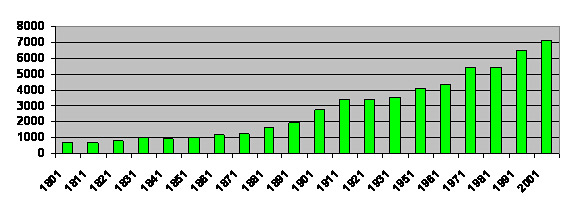| Article compiled by Jan Meads 2005 | |||
|
|||
 |
|||
|
The first written indication of any population in Burton Latimer is the Domesday Survey of 1086 when the village is recorded as having one male and one female servant, 33 villagers, 24 smallholders and 2 slaves living in the
The population fluctuated from this time but not by a great deal as can be seen 500 years later by the records in the parish registers. Most entries in the earliest registers, which start in 1538, are recorded without any information apart from the name and date, therefore it is difficult to tell the reason for the deaths in the parish, but in 1558/9 there were many more burials than usual. This was at the time of a great plague and influenza epidemic throughout the country. Which of these two caused such a large increase in the number of burials cannot be ascertained from the registers but the rate of burials rose from an average of six or seven a year to thirty six and twenty eight respectively. Presumably, because of the deaths, houses became available and it is noticeable that there were a greater number of marriages in the following years and so the population continued to grow at a steady rate. From 1662 to 1689 Charles II who needed money to pay for his war with
150 years later the government decreed that a census should be taken of all persons living in the country and so we have a detailed list of numbers of persons living in Burton Latimer in 1801. It was not popularly accepted, but a good indication of the village's inhabitants at the time can be gathered from the numbers it provided. From that first census to the present day, censuses have been taken every 10 years and they give an indication of the growth of a town or village. Ten years is a long time between censuses and we must bear in mind that a lot can happen during that time. We have to imagine the conditions, the occupations, the epidemics, the weather, the housing and roads which would all have had a bearing on whether people would have wanted to visit and perhaps stay in this place. During the 1700s other lists available for Burton Latimer are the militia lists, these only record men aged 18 to 45 and therefore are not a good indication of the whole population. By the first census in 1801 the population was still only 669 living in 143 houses (an average of 4.68 persons per house), the village had grown little since 1671. Most of the men would have been working on the land either as farmers or agricultural labourers, their wives would have been helping and the children at a very early age would have been bird-scaring, stone-picking, cowslip picking, or acorn gathering as school was not compulsory at this time. Ten years later the population had only increased by 36 but by 1831 the village had grown by a third to 995 persons comprising 199 families, 487 males, 508 females, in 187 inhabited houses, with 3 uninhabited houses. It seemed as if the village was beginning to grow, but not so. 1841 showed a decline by 30 to 965. This was the year that the census changed format and all persons were named. Could this be a reason for the difference in the numbers, had the previous numbers been an educated guess? By 1851 the census format had changed again and more details are available from it. From the occupations given it is obvious that farming is still the main work of the men in the village, followed by the shoemakers, but there were many men occupied in the building trade as stonemasons, masons, builders, carpenters and a plumber and painter. Also there are silk weavers who remind us of one of the earliest uses of the factory site presently occupied by Weetabix. The railway was built in 1857, between the 1851 and 1861 censuses, so there is no indication of the rise in population at the time the navvies were working on the track. By 1861 they had moved on leaving a different form of communication between Burton Latimer and the outside world. Before this time the work was mainly done in the fields or at home, most houses had a "shop" (a brick built barn at the bottom of the garden) where shoe work would be carried out, the women and children helping their menfolk in the various stages of shoemaking or lacemaking in the home. In 1885 Wallis and Linnell built a clothing factory and by 1898 Whitney and Westley had built the first shoe factory in the town. The factories needed workers and the workers needed houses and so from this time Burton Latimer grew quickly and the population did likewise. As well as the men working in agriculture, the various factories, and also at the ironstone quarries, many women were employed at the clothing factories. By 1901 the population had increased to 2774 and to 3420 ten years later. The First World War had a devastating effect upon the population of the whole country and Burton Latimer was no exception. 1921 saw a decline in the population and the number recorded in the census for that year was down to only 3413, but gradually numbers recovered and by the Second World War the town was once again prospering. There was no census taken in 1941 during the war, but the population figures continued to grow until, between 1971 and 1981 the town's sewerage system was unable cope with any extra and a building embargo was imposed until a new system was in place. From 1981 the town's population has continued to grow from its small beginnings in the Domesday record, until in 2001 the population reached 7100 and it is still continuing to expand at a very rapid pace. |
|||